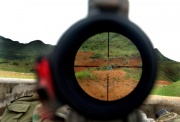Sniper rifle

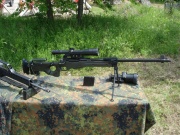
In military and law enforcement terminology, a sniper rifle is a rifle used to ensure accurate placement of shots at greater ranges than other small arms. A typical sniper rifle is built for optimal levels of accuracy, fitted with a telescopic sight and chambered for a military centrefire cartridge. The term is often used in the media to describe any type of accurized firearm fitted with a telescopic sight that is employed against human targets.
The military role of sniper (a term derived from the snipe, a bird which was difficult to hunt and shoot) dates back to the turn of the 18th century, but the sniper rifle itself is a much more recent development. Advances in technology, specifically that of telescopic sights and more accurate manufacturing, allowed armies to equip specially-trained soldiers with rifles that would enable them to deliver precise shots over greater distances than regular infantry weapons. The rifle itself could be a standard rifle (at first, a bolt-action rifle); however, when fitted with a telescopic sight, it would become a sniper rifle.
Contents |
[edit] History
In the American Civil War, Confederate troops equipped with barrel-length three power scopes mounted on the then-premium British Whitworth rifle had been known to kill Union officers at ranges bordering 800 yards, an unheard-of distance at that time.[1][2][3][4]
The earliest sniper rifles were little more than conventional military or target rifles with long-range "peep sights" designed for use on the target range. Only from the beginning of World War I did specially adapted sniper rifles come to the fore, with one of the first scoped military sniper rifles being the SMLE Mk III* (HT).
Typical World War II-era sniper rifles were generally standard issue rifles, hand-picked for accuracy, with a 2.5x telescopic sight and cheek-rest fitted, with the bolt turned down if necessary to allow operation with the scope affixed. By the end of the war, forces on all sides had specially trained soldiers equipped with sniper rifles, and they have played an increasingly important role in military operations ever since.
[edit] Classification
Modern sniper rifles can be generally divided into two basic classes: military and law enforcement.
[edit] Military
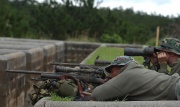
Sniper rifles aimed at military service often deliberately sacrifice a small degree of accuracy to obtain a very high degree of durability, reliability, sturdiness, serviceability and reparability under adverse environmental and combat conditions. Military snipers and sharpshooters may also be required to carry their rifles, along with other equipment, for long distances, making weight considerations very important. Military organizations often operate under strict budget constraints, which influences the type and quality of sniper rifles they acquire.
[edit] Law enforcement
Law enforcement scenarios require the sniper to hit a particular part of the aggressor's body, usually the head. For this reason, sniper rifles used by police forces are generally required to have greater accuracy over military rifles, but at shorter ranges, often less than 100 meters.
Some of the first examples of sniper rifles designed specifically to meet police requirements were those required by West German police corps after the Munich massacre at the 1972 Summer Olympics. The Heckler & Koch PSG1 is one of the rifles designed to meet these criteria, and is often referred to as an ideal example of this type of sniper rifle. The FN Special Police Rifle is another example of a rifle aimed at law enforcement rather than military agencies.
Compared to military rifles, police sniper rifles are heavier, and have a shorter overall length for increased manoeuvrability in urban areas. Police rifles have superior accuracy and tighter tolerances in construction, and cost more, since budgetary restrictions on police departments often allow more expensive rifles to be acquired.
[edit] Distinguishing characteristics
Sniper rifle features can vary widely depending on the specific tasks it is intended to perform. Features that may distinguish a sniper rifle from other weapons are the presence of a telescopic sight, unusually long overall weapon length[5] a stock designed for firing from a prone position, and the presence of a bipod and other accessories.
[edit] Telescopic sight
The single most important characteristic that sets a sniper rifle apart of other military or police small arms is the mounting of a telescopic sight, which is relatively easily distinguishable from smaller optical aiming devices found on some modern assault rifles and submachine guns.
A telescopic sight allows a person to see targets more precisely by virtue of the magnified image it offers, and therefore aim the rifle more accurately. The telescopic sights used on sniper rifles differ from other optical aiming devices in that they offer much greater magnification (more than 4x and up to 40x) and much larger objective lens (40 to 50 mm in diameter), resulting in a brighter image. Most telescopic lenses employed in military or police roles have special reticles to aid with judgment of distance, which is an important factor in accurate shot placement due to the bullet's trajectory.
[edit] Action
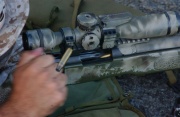
The choice between bolt-action and semi-automatic (more commonly recoil or gas operation) is usually determined by specific requirements of the sniper's role as envisioned in a particular organisation, with each design having advantages and disadvantages. For a given cartridge, a bolt-action rifle is cheaper to build and maintain, more reliable and accurate, and lighter; this is due to fewer moving parts in the mechanism. In addition, the lack of an external magazine allows for more versatile fire-positioning and manual case ejection allows for greater discretion. Semi-automatic weapons can serve a cross-purpose use as both a battle rifle and a sniper rifle, and allow for a greater rate (and hence volume) of fire. As such rifles may be modified service rifles, an additional benefit can be commonality of operation with the issued infantry rifle. A bolt-action is the most commonly used in both military and police roles due to its higher accuracy and ease of maintenance. Anti-materiel applications such as mine clearing and special forces operations tend to see a higher usage of semi-automatics.
A designated marksman rifle (DMR) is less specialised than a typical military sniper rifle, often only intended to extend the range of a group of soldiers. Therefore, when a semi-automatic action is used it is due to its ability to cross over into roles similar to the roles of standard issue weapons. There may also be additional logistical advantages if the DMR uses the same ammunition as the more common standard issue weapons. These rifles enable a higher volume of fire, but sacrifice some long range accuracy. They are frequently built from existing selective fire battle rifles or assault rifles, often simply by adding a telescopic sight and adjustable stock.
A police semi-automatic sniper rifle may be used in situations that require a single sniper to engage multiple targets in quick succession, and military semi-automatics like the M110 SASS are used in similar "target-rich" environments.
[edit] Cartridge
In a military setting, logistical concerns are the primary determinant of the cartridge used, so sniper rifles are usually limited to rifle cartridges commonly used by the military force employing the rifle. Since large national militaries generally change slowly, military rifle ammunition is frequently battle-tested and well-studied by ammunition and firearms experts. Consequently, police forces tend to follow military practices in choosing a sniper rifle cartridge instead of trying to break new ground with less-perfected (but possibly better) ammunition.
Before the introduction of the 7.62x51mm cartridge in the 1950s, standard military cartridges utilised were the .30-06 Springfield (United States), .303 British (United Kingdom) and 7.92x57mm (Germany). The .30-06 Springfield continued in service with U.S. Marine Corps snipers during the Vietnam War in the 1970s, well after general adoption of the 7.62x51mm. At the present time, in both the Western world and within NATO, 7.62x51mm is currently the primary cartridge of choice for military and police sniper rifles.
Worldwide, the trend is similar. The preferred sniper cartridge in Russia is another .30 calibre military cartridge, the 7.62x54mm R, which has similar performance to the 7.62x51mm. This cartridge was introduced in 1891, and both Russian sniper rifles of the modern era, the Mosin-Nagant and the Dragunov sniper rifle, are chambered for it.
Certain commercial cartridges designed without the logistical constraints of most armies with only performance in mind have also gained popularity in the 1990s. These include the 7 mm Remington Magnum, .300 Winchester Magnum, and the .338 Lapua Magnum. These cartridges offer better ballistic performance and greater effective range than the 7.62x51mm. Though they are not as powerful as .50 calibre cartridges, they also do not suffer any weight penalty as is the case for rifles chambered for .50 calibre ammunition, and offer a significant improvement over rifles chambered for 7.62x51mm.
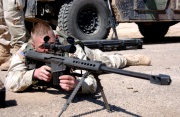
Snipers may also employ anti-materiel rifles in sniping roles against targets such as vehicles, equipment and structures, or for the long-range destruction of explosive devices. Although designed and employed primarily as anti-materiel rifles, they may also be used against personnel.
Anti-materiel rifles tend to be semi-automatic and of a larger calibre than anti-personnel rifles, such as the .50 BMG, 12.7x108mm Russian or even 14.5x114mm Russian and 20mm cartridges. These large cartridges are required to be able to fire projectiles containing usable payloads like explosives, armour piercing cores, incendiaries or combinations of the above, like the Raufoss Mk211 projectile. Due to the considerable size and weight of anti-materiel rifles, snipers operating in 2- or 3-man teams become a necessity.
[edit] Barrel
Barrels are normally of precise manufacture and of a heavier cross section than more traditional barrels in order to reduce the change in impact points between a first shot from a cold barrel and a follow-up shot from a warm barrel. Unlike many battle rifles and assault rifles the bores are usually not chromed to avoid potential inaccuracy due to an uneven treatment.
When installed, barrels are often free-floated or installed so the barrel only contacts the rest of the rifle at the receiver to minimise the effects of pressure on the fore-end by slings, bipods, or the sniper's hands. The end of the barrel is usually crowned or machined to form a rebated area around the muzzle proper to avoid asymmetry or damage and therefore inaccuracy. Alternately, some rifles like the Dragunov or Walther WA2000 provide structures at the fore-end to provide tension on the barrel in order to counteract barrel droop and other alterations in barrel shape.
Another trait sometimes seen with sniper barrels are external longitudinal fluting that contributes to heat dissipation by increasing surface area while simultaneously decreasing the weight of the barrel.
Sniper rifle barrels may also utilise a threaded muzzle or combination device (muzzle brake or flash suppressor and attachment mount) to allow the fitting of a sound suppressor. These suppressors often have means of adjusting the point of impact while fitted.
Military sniper rifles tend to have longer barrels of around 23.5 inches (600 mm) to allow cartridge propellant to fully burn and attain the optimum combination of accuracy and bullet velocity. This reduces muzzle flash, helping to keep the sniper concealed. Police sniper rifles may use shorter barrels to improve handling characteristics. The shorter barrels' velocity loss is less important at closer ranges where projectile energy remains well in excess of that needed to reliably perform.
[edit] Stock
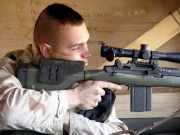
The most common special feature of a sniper rifle stock is the adjustable cheek piece, where the shooter's cheek meets the rear of the stock. For most rifles equipped with a telescopic sight, this area is raised slightly, because the telescope is positioned higher than the iron sights. A cheek piece is simply a section of the stock that can be adjusted up or down to suit the individual shooter. To further aid this individual fitting, the stock can sometimes also be adjusted for length, often by varying the number of inserts at the rear of the stock where it meets the shooter's shoulder. Sniper stocks are typically designed to avoid making contact with the barrel of the weapon.
[edit] Accessories
An adjustable sling on the rifle is often employed. It is used by the sniper to achieve better stability when standing, kneeling, or sitting. The sniper uses the sling to "lock-in" by wrapping their non-firing arm into the sling forcing their arm to be still.
Sniper rifles usually are fitted with a bipod. These bipods act as a stand to stabilize the rifle during firing. Bipods are generally carried by the spotter or are mounted on the gun. Sniper rifles often have specialised accessories, such as variable length gas-strut bipods.
[edit] Capabilities
[edit] Accuracy
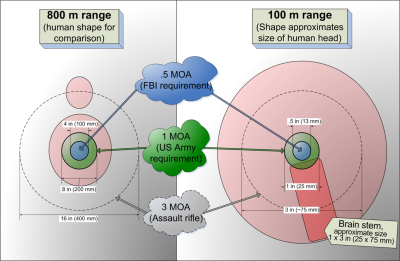
Contrary to popular belief, sniper rifles are not necessarily characterised by exceptional accuracy, especially when compared to civilian sporting rifles, though they nearly always match or exceed the capabilities of other rifles in the military and police categories. A military-issue battle rifle or assault rifle is usually capable of between 3 and 6 minute of arc (MOA) accuracy. A standard-issue military sniper rifle is typically capable of 0.5 to 2 MOA accuracy, with a police sniper rifle capable of 0.25 to 1.5 MOA accuracy. For comparison, a competition target rifle may be capable of accuracy levels up to 0.1 MOA.
The United States military standards call for 1 MOA accuracy from a standard issue sniper rifle since accuracy is sacrificed in favor of low cost and reliability in harsh environments, as well as ease of operation and maintenance. This level of accuracy roughly translates into a variance in the bullet's point of impact of 8 inches at 800 yards, which is considered sufficient to ensure a high probability of hitting a human shape at that distance.
Although accuracy standards for police rifles do not widely exist, they are frequently seen with accuracy levels from 1.5 MOA to as high as 0.5 MOA[6] — and occasionally as high as .25 MOA in the most expensive models.
For typical policing situations an accuracy level of 1 MOA is usually all that is required. This is because police typically employ their rifles at very short ranges.[7] At 100 yards or less, a rifle with a relatively low accuracy of only 1 MOA should be able to repeatedly hit a 1 inch target. One inch is approximately the size of a man's thumb, which is smaller than the brain stem which is targeted by police snipers for its quick killing effect.[8]
[edit] Maximum effective range
| Cartridge | Maximum effective range |
|---|---|
| 5.56x45mm | 300–500 m |
| 7.62x51mm | 800–1,000 m |
| 7.62x54mm R | 800–1,000 m |
| 7 mm Remington Magnum | 900–1,100 m |
| .300 Winchester Magnum | 900–1,200 m |
| .338 Lapua Magnum | 1,300–1,600 m |
| .50 BMG (12.7x99mm NATO) 12.7x108mm (Russian) |
1,500–2,000 m |
| 14.5x114mm | 1,900–2,300 m |
Unlike police sniper rifles, military sniper rifles tend to be employed at the greatest possible distances so that range advantages like the increased difficulty to spot and engage the sniper can be exploited. However, machine guns, battle rifles, counter-sniper rifles and designated marksman rifles can reach or even exceed the range of a sniper rifle.
The most popular military sniper rifles (in terms of numbers in service) are chambered for .308 caliber ammunition, such as 7.62x51mm and 7.62x54mm R. Since sniper rifles of this class must compete with several other types of military weapons with similar range, snipers invariably must employ skilled field craft to conceal their position.
The recent trend in specialised military sniper rifles is towards larger calibres that have greater range, such as the anti-personnel .338 Lapua Magnum cartridge and anti-materiel cartridges like the .50 BMG and the 14.5x114mm. This allows snipers to take fewer risks, and spend less time finding concealment when facing enemies that are not equipped with similar weapons.
[edit] See also
[edit] Notes
- ↑ Snipers in History
- ↑ Whitworth Rifle No. C529
- ↑ Whitworth Sharpshooter Rifle
- ↑ Artillery of the Civil War
- ↑ The Ultimate Sniper: an Advanced Training Manual for Military and Police Snipers, Maj. John L. Plaster, 1993. The information about counter-sniper operations describes techniques for identifying snipers amongst groups of other soldiers. The most easily recognizable feature of a sniper from a great distance is the fact that the sniper's rifle is longer than all the others.
- ↑ The FBI, a national-level policing organization, has recently specified an accuracy level of .5 MOA for sniper rifles issued to their SWAT teams: Johnson, D: Precision Pair, Guns & Ammo, February 2005. [1]
- ↑ Minimum documented range is 5 yards, maximum documented range is 187 yards: Police Sniper Utilization Survey, American Sniper Association, 2006, full report available to military and law enforcement agencies only.[2] [3] Some information publicly available from The Ultimate Sniper: an Advanced Training Manual for Military and Police Snipers, Major John Plaster, 1993.
- ↑ Police Sniper Training, Major John Plaster, 1990.[4]
- ↑ Common Calibers Used by Snipers
[edit] External links
- Modern Firearms list of sniper rifles
- SniperCentral list of sniper rifles
- Mcmillan Tactical Stocks — Images of tactical stocks from the world's leading supplier manufacturer
- Tack Driving Tactical Rifle from Tac Ops — Detailed overview of the accurization process for a .25 MOA rifle
- Detailed accuracy articles, by famous barrel maker Dan Lilja
- Detail of Russian snipers and sniper rifles of World War Two by Chris Eger, military historian
- demigodllc.com: Practical long-range rifle shooting

